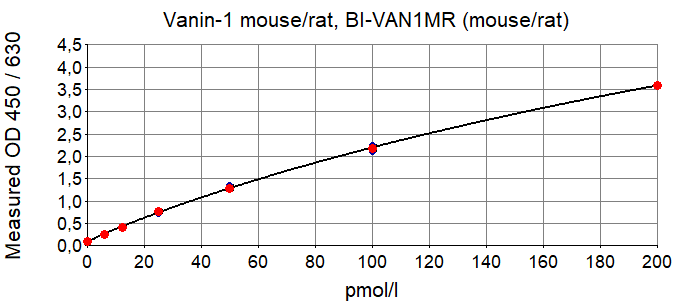Vanin-1 urinary ELISA
BI-VAN1U
Assay Sample Typeurine
Product group Assays
Overview
- SupplierBiomedica
- Product NameHuman Vanin-1 (urine) ELISA
- Delivery Days Customer7
- ApplicationsELISA
- Applications SupplierELISA
- Assay Detection Range9.6-1200 pmol/l
- Assay Precisionintra-assay: 7%, inter-assay: 5%
- Assay Sample Typeurine
- Assay Sensitivity9.6 pmol/l
- Assay Test PrincipleSandwich ELISA
- Assay Time4.5h
- CertificationResearch Use Only
- Scientific DescriptionProduct Characteristics: The Vanin-1 (urine) immunoassay is a 4.5 h, 96-well sandwich ELISA for the quantitative determination of Vanin-1 in urine. Target Information: Vanin-1 is an epithelial ectoenzyme activating the conversion of pantetheine into pantothenic acid (vitamin B5) and cysteamine. It has been suggested that the release of cysteamine by Vanin-1 promotes oxidative tissue damage and inflammation by inhibiting the activity of antioxidants like superoxide dismutase (SOD) and glutathione (GSH). Indeed, Vanin-1 knockout mice have elevated stores of GSH and are more resistant to oxidative injury induced by whole-body gamma irradiation. On the other hand, several reports indicate that Vanin-1 might also act as tissue sensor for oxidative stress. In mice, antioxidant response-like elements could be identified in the promotor region of Vanin-1, which enhance the expression of Vanin-1 in the presence of oxidative stress. Similarly, Vanin-1 expression was shown to be upregulated in a human proximal tubular cell line after exposure to organic solvents. After renal ischemia-reperfusion in rats, a model involving oxidative tissue damage, renal Vanin-1 expression was also found to be upregulated. The highest levels of Vanin-1 expression could be assigned to renal tubular epithelial cells, while no expression is detectable in glomeruli. Hence, Vanin-1 released from renal cells could be detectable in urine. In a study aimed to identify biomarkers for renal tubular injury, it was shown in a rat model of nephrotoxicant-induced injury that Vanin-1 is upregulated in renal tubules earlier than other markers and shed into urine. Subsequent studies further verified the validity of Vanin-1 as an early biomarker of renal tubular damage in drug-induced acute kidney injury, obstructive nephropathy and hydronephrosis, diabetic nephropathy, renal injury in experimental colitis and spontaneously hypertensive rats under high salt intake. Of note, Vanin-1 seems to have superior predictive value for acute kidney injury than established markers KIM-1, NGAL, or NAG.
- Storage Instruction2-8°C
- UNSPSC41116133

